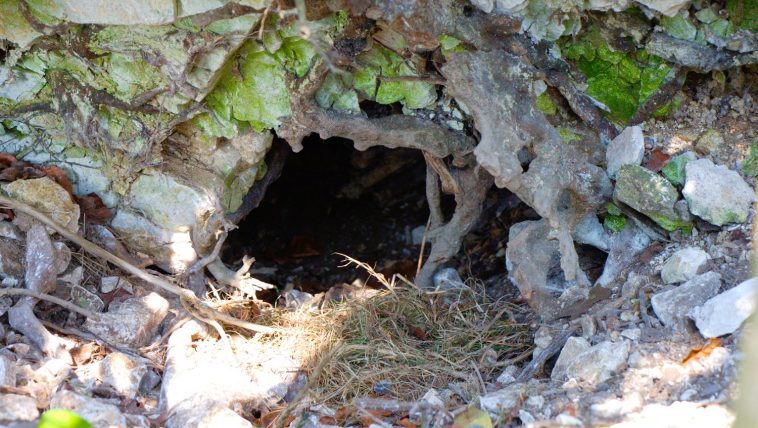Introduction
The nearly complete skeleton of a highly unusual extinct mammal was recently discovered in Madagascar [Editor’s note: the only pictures of this fossil are under copyright, click on “Figures” to see the original study images.] Named Adalatherium, meaning “crazy beast,” it features a suite of enigmatic features not seen in other mammals. However, this fascinating animal has proven to be quite a headache for evolutionists attempting to piece together the early evolution of mammals.
The Madagascan fossils are from the upper Cretaceous system within the Mesozoic erathem, the same layers where we find the last dinosaur fossils. Evolutionists believe Adalatherium lived about 65-70 million years ago.
Adalatherium has been classified as a gondwanatherian, a unique group of animals outside of class Mammalia proper. This means it was different from any of the familiar modern mammals, like placentals and marsupials; in fact, it is technically not even considered a mammal! Instead, it has been placed in the larger group Mammaliaformes.
Previous to the discovery, the only material available for gondwanatherians consisted of highly fragmentary remains. The only other gondwanatherian based on more than teeth is Vintana, for which we also have a skull. Now, Adalatherium has given us many new insights into their skeletal anatomy.
And it turned out to be far stranger than anyone had imagined.
Outlandish Anatomy
Interestingly, Adalatherium was larger than most Mesozoic mammals; in fact, it is the largest known from the Southern Hemisphere. The described specimen was about the size to a cat or badger, which is not particularly large; nevertheless, attributes of the skeleton indicate that it was not fully grown, so adult Adalatherium probably grew significantly larger.
Most mammals from these layers are small and shrew-like, and evolutionists had theorized that mammals did not evolve into diverse sizes and forms until after the dinosaurs went extinct. However, this theory has been challenged by the unearthing of large and specialized Mesozoic mammals such as Repenomamus, Didelphodon, and Castorocauda.1
The large size of gondwanatherians like Vintana and Adalatherium is further confirmation that Mesozoic mammals were not all tiny.
The weirdness of Adalatherium goes far beyond its size, however
It possessed many exceptional features not seen in other groups. For one, it had more back vertebrae than other mammals, as well as a shorter tail. Additionally, its hind legs were strangely shaped and splayed outward like a lizard. This bow-legged arrangement makes it difficult to determine precisely how it moved, though the researchers think it might have burrowed like a groundhog, known as a fossorial lifestyle.
The most outlandish aspect of Adalatherium’s anatomy, however, was the skull. This had an extraordinarily high number of holes, including a unique opening on the top. Nothing like this has ever been observed before, and scientists are unsure what function it might have served.
The snout also had several features that evolutionists consider “primitive.” Other mammals with these features are supposedly hundreds of millions of years older. If they were truly disadvantageous, why were they retained in Adalatherium?
The teeth of Adalatherium are also unusual. Coauthor Dr. Alistair Evans, Associate Professor from the Monash University School of Biological Sciences, said,
The strangeness of the animal is clearly apparent in the teeth—they are backwards compared to all other mammals, and must have evolved afresh from a remote ancestor.”2
In other words, scientists cannot see any potential ancestors with anything remotely similar, so they imagine it must have evolved from something else we’ve never seen.
Likewise, the inner ears have several unique structures. Remarkably, some of these characteristics resemble those of therians (placentals, marsupials, and similar mammals), but are claimed to have evolved independently in the two groups.
Outlandish Theories
With all these peculiarities, evolutionists are at a loss to reconstruct the evolutionary pathway to Adalatherium. It doesn’t seem to fit anywhere on the mammalian evolutionary tree, which is already sketchy and incomplete for Mesozoic mammals. Various portions of its anatomy suggest contradictory relationships, and no possible ancestors are to be found.
Lead author Dr. David Krause admitted that:
Knowing what we know about the skeletal anatomy of all living and extinct mammals, it is difficult to imagine that a mammal like Adalatherium could have evolved; it bends and even breaks a lot of rules.
Convergent Evolution
To explain how this assortment of bizarre features originated in Adalatherium, evolutionists invoke a number of rescuing devices. One of these is convergent evolution, the development of similar traits separately in unrelated organisms.
Convergent evolution, however, is a highly improbable phenomenon. Many evolutionists attempt to rationalize it by asserting that natural selection would cause certain features to evolve in certain environments.
However, this does not explain the origin of these characteristics. The possibility that such complex and perfectly functional structures would randomly evolve even once is astronomically low, and the chances for them to develop several times are almost non-existent.
Furthermore, mutations, the supposed “driving force” of evolution, are incapable of producing new information in an organism’s genome, so it is impossible for an animal ever to gain new traits. Instead, mutations cause degeneration and eventually death. This is far from a satisfactory explanation for convergent evolution or evolution of any kind.
Creationists, on the other hand, believe that God created animal kinds with all the necessary information from the beginning and set limits on the possible variation within each kind. With all of its unique characteristics, Adalatherium was most likely a separate created kind from other mammals.
Insularity
Adalatherium also possessed many traits that are not seen in any other mammals. Evolutionists attribute this to its isolation on Madagascar, where it evolved independently from mammals living on the continents. Here it allegedly developed its distinctive body plan due to the unique pressures of island life. This phenomenon is known as insular evolution.3
Once again, this is not a sufficient explanation for Adalatherium’s unique anatomy, since it cannot account for the acquisition of novel information. Moreover, creationists do not believe that Madagascar was an island before the Flood. Rather, it apparently broke away from India during the year-long cataclysm, subsequently moving to its current position near Africa.
Accordingly, the fossils found on Madagascar were predominantly formed during the Flood from animals in pre-Flood ecological communities, all of which appear to have coexisted on the great supercontinent of Rodinia. Instead of evolving through insularity, it is eminently more reasonable to believe that Adalatherium was created by God to fill a unique pre-Flood niche. Unfortunately, this specialization likely contributed to its eventual extinction.
Conclusion
Adalatherium is another example of the vastly different conclusions that can be made from the same observations based on one’s worldview. An evolutionary worldview has no basis for science and logic and is ultimately self-defeating. Conversely, a Christian interprets the evidence in light of God’s Word. 2 Timothy 3:16-17 declares that “All scripture is given by inspiration of God, and is profitable for doctrine, for reproof, for correction, for instruction in righteousness: That the man of God may be perfect, thoroughly furnished unto all good works.” In the end, the Bible provides a solid foundation to do research and refute the erroneous claims of those who deny their Creator.
Footnotes
- For an overview of several such mammals, see Brian Thomas., “Devils, Dinosaurs, and Squirrel Fossils,” ICR, December 30, 2014
- Silvia Dropulich, “Palaeontologists find full fossil skeleton of bizarre mammal known as the ‘crazy beast from the south’,” Monash University, April 30, 2020, https://www.monash.edu/science/news/current/palaeontologists-find-full-fossil-skeleton-of-bizarre-mammal-known-as-the-crazy-beast-from-the-south.
- Ido Filin and Yaron Ziv, “New theory of insular evolution: unifying the loss of dispersability and body-mass change,” Evolutionary Ecology Research 6 (2004): 115-124







